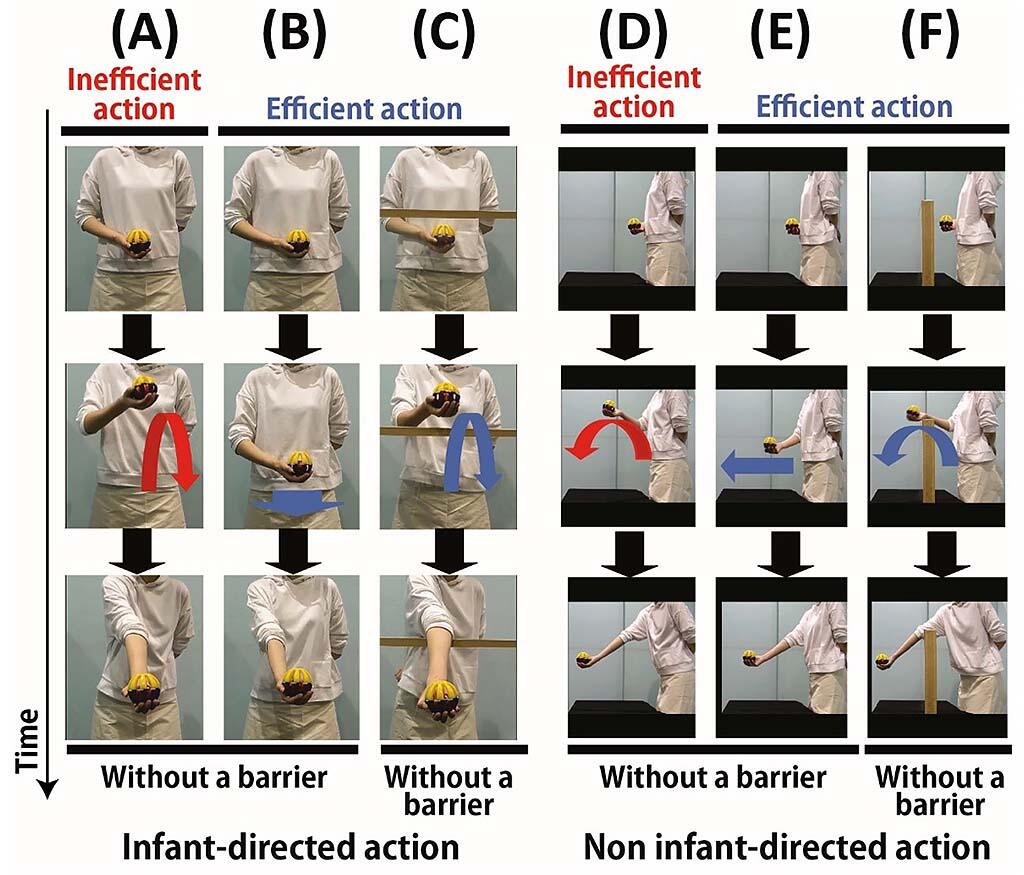The research group of Associate Professor Masahiro Hirai of the Nagoya University Graduate School of Informatics, Associate Professor Yasuhiro Kanakogi of the Osaka University Graduate School of Human Sciences, and Lecturer Ayaka Ikeda of the Senshu University School of Human Sciences, revealed with experiments on 4-month-old and 10-month-old babies that an inefficient movement of presenting toys to babies draws the baby's attention and promotes learning. It was found that 4-month-olds were more attracted to "inefficient (wasteful) movements" than efficient movements directed at them, and that in 10-month-olds it promoted the retention of their memory of the toy. This is expected to be an achievement that will lead to clarification of the learning mechanism of infants. The results were published in the July 14 issue of the international scientific journal Developmental Science.
Infants acquire knowledge after birth through their relationships with the people around them. It has been reported that clear "social signals", such as eye contact and utterances from caregivers attract the attention of babies and promote learning. On the other hand, in daily communication, both parties have dynamic exchanges that include physical movements, and in fact, it is known that babies prefer exaggerated, repetitive movements directed towards them by caregivers called "motionese". However, little is known about what physical movement characteristics attract the baby's attention and promote learning.
In this study, the research group focused on the movement of the hand, in particular when holding out an object towards other people, and 8 experiments were conducted to investigate what characteristics of this behavior promote the attention and learning of babies. Previous studies have shown that 4-month-old children can already distinguish between efficient and inefficient movements, and that 10-month-old children already learn objects using clear signals such as eye contact. For this, Associate Professor Hirai recruited research participants at four and nine-months screening venues in Shimotsuke City, Tochigi Prefecture, where his previous employer, Jichi Medical University, was located. He enrolled a total of 192 subjects, comprising 96 4-month-old children and 96 10-month-old children.
In the study, the authors first presented two videos to 4-month-old children at the same time and investigated whether it was possible to distinguish between the two images by looking at which one the subjects paid attention to (i.e., show preference to) as an index by conducting experiments 1-4 (24 participants in each). Experiment 1 presented two images, one showed a toy moving in a curved motion towards the baby (inefficient movement), and the other shows the toy moving in the hand in a linear motion (efficient movement), and the researchers investigated which video was watched for a longer time by the participants.
Next, in Experiment 2, both images showed the toy with curved movements, but one showed an efficient movement of placing a barrier and movement of the hand to avoid the barrier. It was determined that the participants prefer the image that they stared at for a longer time. In both Experiments 1 and 2, the babies significantly preferred movements that were inefficient.
In Experiments 3 and 4, to investigate whether it is important that the movement is directed towards the baby, the same movement as in Experiments 1 and 2 was shown to the 4-month-old child in profile. In Experiment 3, the participants preferred inefficient movements, but in Experiment 4, they did not. From this, it was shown that for 4-month-old children, movements that were "directed towards themselves (directive)" and "inefficient" may attract attention.

Credit: Masahiro Hirai, Nagoya University
Next, for 10-month-old children, the research group constructed a task to investigate how the "toward-ness" and "inefficiency" of hand movements revealed in Experiments 1 to 4 affect the learning of objects, and experiments 5 to 8 (24 participants each) were conducted. Specifically, after the baby observes the movement of presenting toy A (inefficient movement / efficient movement) four times, toy A or a new toy B that has never been seen is presented. It was judged that learning was established when the participant looked at toy B longer than toy A.
In Experiment 5, the motion of presenting the toy in a curved motion (inefficient motion) toward the baby was shown in the video; in Experiment 6, the motion of placing a barrier and presenting the toy to the baby in a curved motion (efficient motion) in an arc was shown in the video; in Experiment 7, the motion of presenting the toy to the baby in a linear motion (efficient motion) was shown in the video; and in Experiment 8, the movement was presented from the side, and the movement (inefficient movement) of presenting the toy in a curved movement so as to draw an arc not directed at the baby was shown in the video. As a result, attention to the new toy B increased significantly in Experiment 5. On the other hand, attention did not increase in Experiments 6-8.
These results suggest that "toward-ness" and "inefficient movements" for babies may promote object learning in 10-month-old babies. This study is expected to lead to the clarification of the learning principles of infants. Associate Professor Hirai said, "In the future, we plan to proceed with research using a developmental cognitive neuroscience approach to human learning. By investigating the activity of the baby's brain, we are already investigating the mechanism of the brain related to learning based on the movement information of others."
This article has been translated by JST with permission from The Science News Ltd.(https://sci-news.co.jp/). Unauthorized reproduction of the article and photographs is prohibited.




